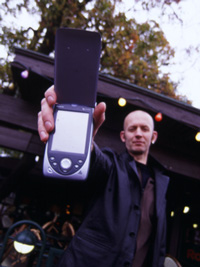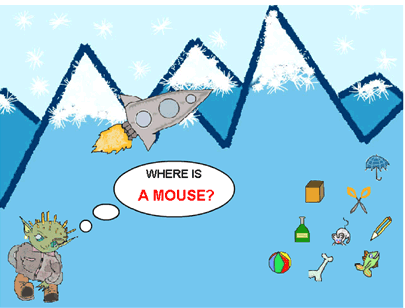|
|||||
Edutainment Game Design for Mobile Digital Televisionby Sonja Kangas Scientists at VTT Information Technology have designed an educational game for mobile television trial terminals IPAQ and Tablet-PC, in order to study ways of providing more interactive content to future mobile television. The 'Mobile Television in 4G Networks' (2001-2003) project was motivated by the increasing significance of mobility and cross media. The project concentrated on a model for associating digital television and wireless data networks by combining broadcast digital television programs (1>N) with more personalised content delivered through cellular and local area networks (eg WLAN). The project was based on VTT studies of personalised interactive content for multiple media systems (IMU and IMU2 projects) and 'edutainment' (education + entertainment). We looked at how personalised multimedia content could be delivered and offered to users through television broadcasts. Because of their data-processing capabilities, mobility and high screen resolution, we used IPAQ (13 x 8.3 x 1.6cm) and Tablet-PC (27.5 x 21.3 x 2.2cm). During the project we conducted technical tests, literary studies and a field trial (81 users) in the city of Tampere, Finland.
We believe mobile television to be the future platform of choice, since televisions and mobile phones are now found in over 90% of homes across Europe. In the first phase we focused on a younger demographic, because new technological services and applications tend to be taken up first and most easily by youth. While we designed an educational language game to be affiliated with a language tutorial on television, the findings can also be applied to eLearning, interactive advertising, intelligent packaging and hybrid media (printed communication connected to digital media).
Our design problem was to meet technical, usability, game design and pedagogical needs. Entertaining applications designed to accompany digital television programs were found to be a focal point, based on our extensive study of mobile entertainment and digital television. We studied the technical development of different (mobile) digital television systems and have pointed out the possibilities inherent in using educational entertainment to motivate users to learn and to participate in a mobile situation. The base of the project is a new digital television multiplex offering 20 Mbit/s bandwidth around Finland and a satellite connection for interactive added-value services abroad. Common (television programs) and user-specific (educational multimedia) content would be linked together and used in mobile 'always on, always with' situations. Educational Entertainment In order to provide competitive and enthralling entertainment for emerging mobile generations, one has to understand what makes successful mobile entertainment. In addition to studying the trends of both mobile entertainment and digital television in Europe and comparing community and gaming possibilities on the Internet, we considered personalisation, localisation and pervasive computing schemas. In educational games there are pedagogical, technical usability and game design aspects to cover. The player is immersed in the game world as an active participant, but is simultaneously an external observer of the educational content. In educational games, the content is embedded in the game but is clearly separate from the game world. In other words, the game world can be imaginary, but the educational content must follow the definitions specified in the relevant syllabus. Findings
We have also identified the importance of smooth and continuous connection between the television program and add-on entertainment. The add-on game should be developed side-by-side with the actual program in order for it to provide the greatest benefit. It was pointed out that social communication between users is an essential aspect of play. Mobile digital television allows users to make use of broadcast, broadband, wireless and local area networks. In the future, mobile entertainment will be even more social, cooperative and interactive, anywhere, anytime and in a more strongly peer-to-peer fashion. Media integration will shape the forms of both entertainment services and terminals. Upward trends include adaptability, pervasive computing, networking, versatile mobile access and user-centred design. Link: Please contact: |
|||||




